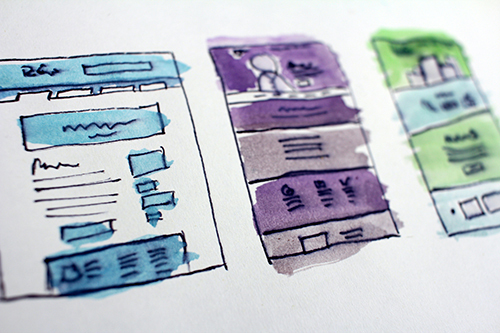As a web designer you have approximately ten seconds to get someone to interact with your site. In that small window of time there are a series of decisions being made that affect whether the user is impressed by what they find or if they move on to another site. By understanding how persuasion is built into a page, a designer can make certain that a user will stay on the page, and more importantly, keep them coming back.
There are three fundamental elements of usability that are essential to the success of a site: navigation, story, and beauty. With some imagination and tailored page arrangement, your site can stand out from all the others.
-
- Navigation
Ease of usability is a major characteristic of a well-designed site. If it is easy to find useful information, the user is more likely to stay and explore. Easy navigation is achieved in the details. This video on the laws of UX argues that election targets such as buttons and links should be large enough to see and be close at hand. There should also be an ever-present header so that no matter where the user finds themselves, they can always go back to where they were. There should also be a prevalent and always-available search bar so that users can find other points of interest on the site, and any selectables should be obvious in their use.
Implementing simple navigation tools and breaking down tasks into small steps will ensure that users don’t get frustrated and leave. Because the average person can only remember about seven units at a time, it is best to create small groups of data so that users don’t become overwhelmed by the site. For the Ooligan site, we decided to keep the rows of books or blogs under seven units and divide the page into seven rows of these units. Keeping the complexity of a page down will be less time-consuming for the user, and they will be happy to stay if they feel like they aren’t wasting their time. Creating appropriate content that loads quickly is the last navigational tactic. Productivity peaks when both a computer and its user interact at a pace under four hundred milliseconds. Users like speed and simplicity, so they will be persuaded to stay if they find what they’re looking for quickly.
-
- Story
According to this video on navigation, hierarchy, and color, every site tells a story. The homepage should have a relevant hero image or logo that represents the brand, followed by social proof that this is a reputable company or establishment. You’ll want to describe the benefits of choosing your company over another and explain the special features of the services that are offered. Follow it up with testimonials from real people who have experience with your company. At Ooligan, our services are similar to other indie publishers, but what makes us stand out is that our press is run by students and every book has a full team working on it to make it the very best it can be. For this reason, our home page highlights our books, the awards we have received, accolades and testimonials from our many authors, and evidence that our students are running the entirety of the press. In order to have a successful page, your visitors must immediately understand what makes you better than everyone else. Keep in mind that your story is also your sales pitch—it’s how you persuade people to engage with you.
-
- Beauty
According to this article, an aesthetically pleasing design is interpreted as being more usable. No one is interested in interacting with an ugly or obnoxious site. To be specific, a beautiful site can be defined as one that has a simple design that isn’t overwhelming. Buttons and other elements should be consistent in color and size so that there’s no confusion about what they represent or the actions that should be taken. Although creativity is essential in web design, users want interfaces to work the same way as others that they interact with; providing familiar design patterns in headers, footers, and buttons will add to the perceived beauty of the site. As humans, we like to see ourselves in everything, so using pictures to convey emotion is a great way to draw people in. First impressions are vital, so if you give your users something pretty to interact with, they are more likely to stay on your page.
The success of your website is determined by the use of all three of these elements. Excluding one of them will decrease a user’s desire to stay on your site. The goal of Ooligan’s new website is to employ these strategies of persuasion throughout its pages and make a site that will be enjoyable to interact with and learn from.

